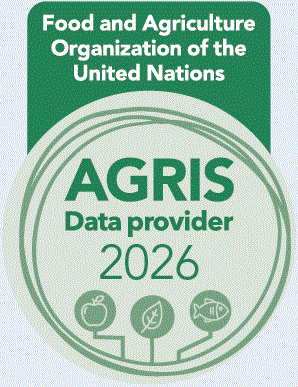New record of six Brachionus species from the South of Iraq
DOI:
https://doi.org/10.58629/ijaq.v19i2.420Keywords:
18S rRNA gene, Brachionus, Rotifers, biotechnology.Abstract
In this survey, six species of Brachionus genus are indexed as new record in the south Iraqi water resource at the first time in Iraq depending on the sequence of 18S rRNA gene, these species were registered as a new record in Iraq and the other two species which are HH1 and HH2 were registered in the National Center for Biotechnology Information (NCBI), The European Nucleotide Archive (ENA) and DNA Data Bank of Japan (DDBJ) sequentially.Metrics
References
Ahmed, H.K. and Ghazi, A.H. (2009). A taxonomical and environmental study of the genus Brachionus (Rotifera: Monogononta) (Pallas, 1776) in Al-Hammer marsh, south of Iraq. Iraqi J. Aquacult., 6(2): 105-112.
Abdul-Hussein, M.M.; Al-Saboonchi, A.A. and Ghani, A.A. (1989). Brachionid rotifers from Shatt Al-Arab River, Iraq. Mar. Mesopot., 4(1): 1-17.
Akter, S.; Shahjaham, M.; Rahman, M.S. and Das, P.S. (2013). Suitability of Chlorella ellipsoidea as food for production of the rotifer Brachionus calyciflorus. Inter. J. Agric. Res, Innov.Technol. (IJARIT), 3(20): 41-48.
Dhert, P. (1996). Rotifers in : Lavens, P. Sorgeloos, P. (Eds). Manual on the production and use of live food for aquaculture. FAO Fish. Tec. Pap., Vol. 361, 61-100.
Gallardo, W.G.; Hagiwara, A. and Snell, T.W. (2000). Effect of juvenile hormone and serotonin (5-HT) on mixis induction of the rotifer Brachionus plicatilis Mu¨ ller. J. Exp. Mar. Biol. Ecol., 252, 97–107.
Garey, J.R.; Schmidt-Rhaesa, A.; Near, T.J. and Nadler, S.A. (1998). The evolutionary relationships of rotifers and acanthocephalans. Hydrobiologia, 387/388, 83-91.
Gilbert, J.J. and Walsh, E.J. (2005). Brachionus calyciflorus is a species complex: mating behavior and genetic differentiation among four geographically isolated strains. Hydrobiologia, 546: 257–265.
Go´mez, A.; Serra, M.; Carvalho, G.R. and Lunt, D.H. (2002). Speciation in ancient cryptic species complexes: evidence from the molecular phylogeny of Brachionus plicatilis (Rotifera). Evol., 56, 1431–1444.
King, C.E. (1972). Adaptation of rotifers to seasonal variation. Ecol., 53, 408–418.
Liu, Z.J. and Cordes, J.F. (2004). DNA marker technologies and their applications in aquaculture genetics. Aquaculture, 238, 1–37.
Lubzens, E.; Zmora, O. and Barr, Y. (2001). Biotechnology and aquaculture of rotifers. Hydrobiologia, 446/447: 337-353.
Ortells, R.; Gómez, A. and Serra, M., (2003). Coexistence of cryptic rotifer species: ecological and genetic characterization of Brachionus plicatilis. Freshw. Biol. 48(12), 2194–2202.
Hassan, H.F.; Al-Badran, A.E.; and Ali, M.H. (2021). Molecular identification of new global isolate record of Brachionus calyciflorus named HH1. Iraqi J. Aquacult., 18(1): 19-31.
Hammadi, N.S. (2010) . An Ecological Study of the Rotifera of Shatt Al-Arab Region . PhD. thesis, Coll. Agric. Univ. Basrah
Papakostas, S.; Triantafyllidis, A.; Kappas, I. and Abatzopoulos, T.J. (2005). The utility of the 16S gene in investigating cryptic speciation within the Brachionus plicatilis species complex. Mar. Biol. 147, 1129–1139.
Papakostas, S.; Dooms, S.; Triantafyllidis, A.; Deloof, D.; Kappas, I.; Dierckens, K.; De Wolf, T.; Bossier, P.; Vadstein, O.; Kui, S.; Sorgeloos, P.; and Abatzopoulos, T.J. (2006). Evaluation of DNA methodologies in identifying Brachionus species used in European hatcheries. Aquaculture 255, 557–564.
Sabri, A.W. (1988). Ecological studies on Rotifera (Aschelminthes) in the Tigris River, Iraq. Acta. Hydrobiologia, 30:367-379.
Sato, M.; Kawamata, K.; Zaslavskaya, N.; Nakamura, A.; Ohta, T.; Nishikiori, T.; Brykov, V. and Nagashima, K. (2005). Development of microsatellite markers for Japanese scallop (Mizuhopecten yessoensis) and their application to a population genetic study. Mar. Biotech. 7, 713–728.
Tayade, S.N.; and Dabhade, D.S. (2011). Checklist of rotifers in Wasim district of Maharashtra, India. Int. J. Innov. Bio. Sci., 1, 27-31.
Winnepenninckx, B.; Backeljau, T.; Mackey, L.Y.; Brooks, J.M.; De Wachter, R.; Kumar, S. and Garey, J.R. (1995). 18S rRNA data indicate that the aschelminthes are polyphyletic in origin and consist of at least three distinct clades. Mol. Biol. Evol., 12: 1132–1137.
Downloads
Published
How to Cite
Issue
Section
License
Copyright (c) 2022 Iraqi Journal of Aquaculture

This work is licensed under a Creative Commons Attribution 4.0 International License.










